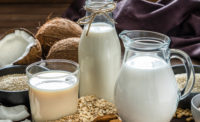Repurposing food waste
Upcycled ingredients, whey from cheesemaking, oat milk byproducts have a second life in other products

Photo courtesy of OlgaLepeshkina / iStock / Getty Images Plus

With the growing world population, there is tremendous environmental stress on our planet because of the exploitation of non-renewable food and energy resources. To overcome these challenges, innovative approaches such as using renewable resources and repurposing waste are required to feed the current and future global population.
In the past few decades, scientists have been working on developing novel technologies to increase agricultural productivity (higher crop yields) and food production and processing efficiency to meet the growing food demand. With the increased food production, we are also facing the challenge of treatment and utilization of food waste. The researchers have found that about 33% of the food is lost during harvesting, storage, transportation, and at the consumer level, which contributes to 9.3 billion MT of CO2 generation, about half of the global food system’s total emissions in 2017.
Just four countries (China, the United States, India, and Brazil) contributed 44.3% of the total food waste production. As per the EPA (U.S. Environmental Protection Agency), over one-third of the food produced in the U.S. is never eaten and wasted in the garbage. The generation of this waste has a myriad of economic, social, and environmental impacts.
Prevention is not the only cure! Although actions can be taken to prevent food waste, e.g., by avoiding its generations at source (e.g., optimizing food production processes) or by redistributing surplus food through a viable supply chain, there will always be an amount of food waste which can never be eliminated either due to non-palatable nature or it is too expensive to repurpose. As per the EPA, the U.S. food industries generated about 93 million MT of food waste in 2020.
Reducing food losses by 2030
The United Nations is targeting the Sustainable Development Goals that aims at a 50% reduction of per capita global food waste at retail and consumer levels and on reducing food losses along production and supply chains by 2030 (UNEP, 2015). To achieve these goals, many countries have defined their national targets and built strategies to implement them.
The food community (academic organizations and food industries) has come together to make good use of food waste by adopting new technologies and processes and conducting new research. Upcycling, biorefinery, valorization of food waste, etc. are some of the concepts that have gained popularity in recent years.
Consumers’ growing concerns around the disposal and/or utilization of food waste are accelerating the use of new ingredients, packaging, and innovation in food industries. Many companies have started using the byproducts (produced by them or other industries) as an “upcycled” ingredient in their food products. For example, upcycled (or value-added) ingredients that can be used in other food products include byproducts of oat milk production, whey from the cheese industry, and spent grain from breweries.
The benefits of using these low-value product streams and applying appropriate preservation techniques enable the final product to have a longer shelf life and be safe for human consumption.
A variety of chemicals, nutrients, biofuels, and materials can be produced from food waste by utilizing the integrated biorefinery approach. The chemical composition of food waste is key to its potential valorized reuse applications. For example, valorization of fish industry waste will produce enzymes (esterase and protease), omega-3 fatty acids; valorization of egg processing wastes will produce calcium-rich salts (phosphate, carbonate, and oxides). Similarly, dietary fiber, fermentable sugars, hydrocolloids, etc. are the byproducts of oil-crop processing waste. On the other hand, whey will yield protein, lactose, minerals, and vitamins produced during the valorization of cheese whey.
Understanding the nutritional value of whey
The dairy industry has an important position among the food industries with widespread products such as cheese, yogurt, butter, and ice cream. Due to its perishable nature and rich nutrients, dairy products significantly contribute to food waste and can have a serious impact on the environment if not handled appropriately. Whey is the largest volume co-product of the dairy industry and the main food waste from dairy operations. In 2022, the US produced about 6.5 MMT of cheese (USDA). During cheese production, about 80-90% of milk volume is expelled as whey.
Whey contains a wide range of micro-nutrients with very high nutritional value and biological activities. Over two to three decades, a significant amount of research has been conducted to isolate and understand the chemical composition of whey. With advanced technologies (such as nanofiltration, electrodialysis, reverse osmosis), pure protein fractionation, and high-quality whey protein, lactose and mineral powders can be produced. All these fractionated “value-added” byproducts are very popular in energy drinks, supplements, cosmetics, and pharmaceuticals. Precise microbial fermentation of dairy waste also is utilized to produce biofuels (methane, biohydrogen, ethanol, biodiesel) which can be used as an alternative energy source.
Besides using these new technologies, the food industries are also boosting awareness about reducing food waste at the consumer and community level by collaborating with local authorities and non-profit organizations to collect and donate surplus food in food banks, educating them on the proper disposal of food and packaging materials. To make our dream of being carbon neutral true, educated consumers must take responsibility to minimize the food waste in their day-to-day lives.
Looking for a reprint of this article?
From high-res PDFs to custom plaques, order your copy today!







